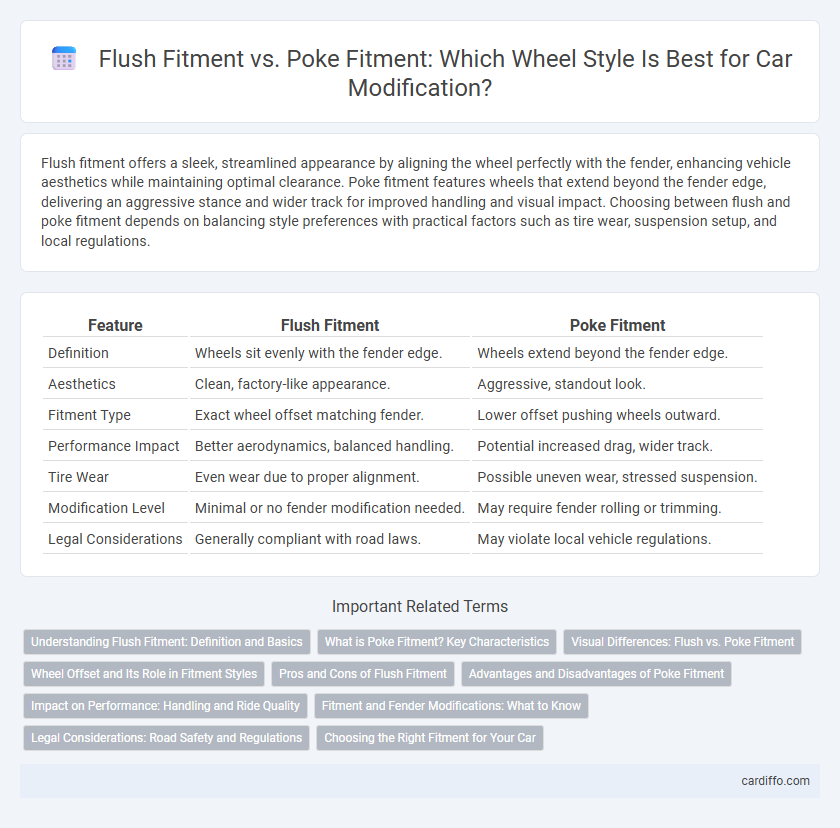Flush fitment offers a sleek, streamlined appearance by aligning the wheel perfectly with the fender, enhancing vehicle aesthetics while maintaining optimal clearance. Poke fitment features wheels that extend beyond the fender edge, delivering an aggressive stance and wider track for improved handling and visual impact. Choosing between flush and poke fitment depends on balancing style preferences with practical factors such as tire wear, suspension setup, and local regulations.
Table of Comparison
| Feature | Flush Fitment | Poke Fitment |
|---|---|---|
| Definition | Wheels sit evenly with the fender edge. | Wheels extend beyond the fender edge. |
| Aesthetics | Clean, factory-like appearance. | Aggressive, standout look. |
| Fitment Type | Exact wheel offset matching fender. | Lower offset pushing wheels outward. |
| Performance Impact | Better aerodynamics, balanced handling. | Potential increased drag, wider track. |
| Tire Wear | Even wear due to proper alignment. | Possible uneven wear, stressed suspension. |
| Modification Level | Minimal or no fender modification needed. | May require fender rolling or trimming. |
| Legal Considerations | Generally compliant with road laws. | May violate local vehicle regulations. |
Understanding Flush Fitment: Definition and Basics
Flush fitment refers to aligning the outer edge of a wheel precisely with the vehicle's fender, creating a sleek, cohesive look without extending beyond the body panel. This style minimizes wheel gap and promotes improved aerodynamics compared to poke fitment, where wheels protrude outward past the fender line. Achieving perfect flush fitment requires careful consideration of wheel offset, tire dimensions, and suspension setup to maintain optimal performance and appearance.
What is Poke Fitment? Key Characteristics
Poke fitment refers to a wheel stance where the rim extends slightly beyond the fender edge, creating a noticeable outward projection. Key characteristics include increased tire width exposure, a more aggressive aesthetic, and potential changes in vehicle handling due to altered track width. Unlike flush fitment, where the wheel sits evenly with the fender, poke fitment emphasizes visual stance by pushing the wheel outward.
Visual Differences: Flush vs. Poke Fitment
Flush fitment features wheels aligned precisely with the fender, creating a sleek, integrated look that enhances the vehicle's visual width and stance. Poke fitment occurs when the wheels extend slightly beyond the fender edge, offering a more aggressive and standout appearance by emphasizing the wheel's size and offset. The visual difference significantly impacts the car's style, with flush fitment favoring subtlety and poke fitment delivering boldness.
Wheel Offset and Its Role in Fitment Styles
Wheel offset plays a critical role in determining flush fitment versus poke fitment styles, affecting how the wheel aligns with the fender. A flush fitment requires a wheel offset that positions the tire edge almost perfectly with the fender lip, creating a sleek, seamless look. Conversely, poke fitment necessitates a lower offset, pushing the wheels outward beyond the fender, emphasizing aggressive stance and wider track width.
Pros and Cons of Flush Fitment
Flush fitment offers a sleek, modern appearance by aligning the wheel edge precisely with the fender, enhancing the vehicle's aerodynamics and visual appeal. It reduces the risk of tire rub and debris accumulation, contributing to better handling and tire longevity. However, flush fitment may increase the likelihood of wheel damage from road hazards due to minimal tire protection and can lead to a harsher ride because of reduced tire sidewall cushioning.
Advantages and Disadvantages of Poke Fitment
Poke fitment allows wheels to extend beyond the fender, providing an aggressive stance and improved handling through wider track width. However, it increases the risk of debris hitting the fender and potential damage to suspension components due to reduced clearance. Additionally, poke fitment may lead to legal issues or fail vehicle inspections in some regions because of tire coverage regulations.
Impact on Performance: Handling and Ride Quality
Flush fitment improves vehicle handling by aligning tires evenly with the fender, optimizing aerodynamics and reducing drag, which enhances stability during high-speed cornering. In contrast, poke fitment, where tires extend beyond the fender, can negatively affect ride quality by exposing suspension components to debris and increasing tire wear due to uneven contact with road surfaces. Proper flush fitment balances aesthetics with performance, ensuring better tire grip and smoother ride dynamics.
Fitment and Fender Modifications: What to Know
Flush fitment ensures the tire sits even with the fender edge, requiring precise suspension tuning and sometimes minor fender rolling for optimal clearance. Poke fitment involves tires extending beyond the fender, often demanding wider fenders or additional fender flares to prevent debris from being thrown on the vehicle. Proper fender modifications safeguard against tire rub and maintain vehicle legality, crucial for both flush and poke fitment setups.
Legal Considerations: Road Safety and Regulations
Flush fitment aligns wheels precisely with the fender, enhancing vehicle stability and complying with most road safety regulations, whereas poke fitment, with wheels extending beyond the fender, often violates legal standards due to increased risk of debris impact and reduced protection. Many jurisdictions enforce strict guidelines on wheel protrusion to maintain safe clearance and prevent damage to other vehicles or pedestrians. Failure to adhere to these legal considerations can result in fines, failed inspections, and liability issues in the event of accidents.
Choosing the Right Fitment for Your Car
Selecting the right fitment for your car depends on aesthetics, wheel functionality, and performance preferences. Flush fitment aligns the wheel edge evenly with the fender, enhancing a sleek and aggressive stance while minimizing debris accumulation. Poke fitment, where wheels extend slightly beyond the fender, offers a more muscular look but may increase exposure to road elements and potential handling changes.
flush fitment vs poke fitment Infographic

 cardiffo.com
cardiffo.com